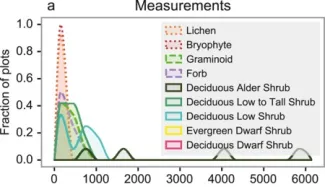Integrating Arctic plant functional types in a land surface model using above- and below-ground field observations
Field observations of community composition improve how plant functional types (PFT) are represented in E3SM simulations.
Assess whether plot-scale measurements of species diversity, plant biomass, and its allocation above- and below-ground can improve PFT representation in the E3SM land model (ELM).
Six dominant plant communities were surveyed along a hillslope gradient at the Kougarok field site and were characterized along with extensive site details.
Nine PFTs were identified and incorporated into ELM; simulations were run to assess improvement against original configuration of the model (e.g., grasses and shrubs).
New PFTs improved representation of the variability in biomass across different plant communities in the study area, particularly for highly productive alder shrublands.
When projected into future climate conditions (RCP 8.5 through 2100), simulations with arctic PFTs showed increased vegetation C storage in communities dominated by alders and other tall shrubs.
Sulman et al. 2021. Integrating Arctic plant functional types in a land surface model using above- and below-ground field observations. Journal of Advances in Modeling Earth Systems, 13, e2020MS002396. DOI: 10.1029/2020MS002396.
This research was supported by the Director, Office of Science, Office of Biological and Environmental Research of the US Department of Energy under Contract No. DE-AC02-05CH11231 as part of the Next-Generation Ecosystem Experiments (NGEE Arctic) project.


